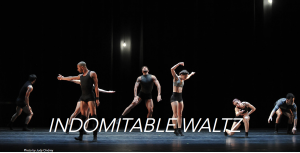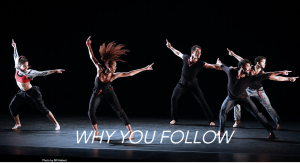Cuban Malpaso Dance Makes Rapturous San Diego Debut
 “Indomitable Waltz” opened Malpaso Dance Company’s program at UCSD’S Mandeville Theatre on Friday. And, in the first moments of its San Diego debut, this Cuban modern dance troupe indeed looked indomitable—tough and invincible.
“Indomitable Waltz” opened Malpaso Dance Company’s program at UCSD’S Mandeville Theatre on Friday. And, in the first moments of its San Diego debut, this Cuban modern dance troupe indeed looked indomitable—tough and invincible.
Powerful movers with bodybuilder thighs, they jerkily angled knees, hips, and elbows, as if resisting the fluid score (Alexander Balanescu’s “Waltz,” recorded by the Balanescu Quartet). A wary community, the eight dancers were like strangers stuck at a fogged-in airport. There was a sense of “We’re all in this together” and moments of unison, but no one touched, and there was no sign of mutual support.
And then. Two hand-holding trios formed, my whole body went “Ah,” and “Indomitable Waltz” became one of the most satisfying dances I’ve ever seen. As the dancers continued to join in twos, threes, and circles, at one point holding each other’s heads as if in benediction, that connection—and the contrast with their initial isolation—felt rapturous.
“Indomitable Waltz” (2016) was created for Malpaso Dance by Aszure Barton, an in-demand Brooklyn-based choreographer, and that’s part of a larger story. Cuba has long been known for its excellence in ballet, thanks to major government support and to Alicia Alonso. Alonso, a prima ballerina at American Ballet Theatre in the 1950s, returned to her native Cuba after Fidel Castro came to power and founded the country’s National Ballet. And a number of Cuban-trained ballet dancers have ended up in companies outside the country—for instance, Carlos Acosta, Lorena and Lorna Feijoo, José Manuel Carreño, and Xiomara Reyes.
But Cuban modern dance has been lower on the international radar, hampered in part by the lack of cultural exchange between Cuba and the U.S. As that relationship warmed, in 2013 the Joyce Theatre commissioned New Yorker Ronald K. Brown to create a piece for a Cuban company; Brown chose Malpaso, which was at that time just one year old. Now an associate company of Joyce Theatre Productions, Malpaso continues to add works by U.S. artists to its repertory.
 Brown’s piece for Malpaso, “Why You Follow” (2014), was also on the UCSD program. Brown has extensively studied West African dance, and, while he often combines some African-flavored movement with modern, in “Why You Follow” he went all out. Set to exuberant music by African artists, the choreography demands a low center of gravity, arm flings that defy shoulder anatomy, and hypermobile backs. In one killer move, dancers hold a deep plié and swivel one knee in, while keeping the rest of the body still.
Brown’s piece for Malpaso, “Why You Follow” (2014), was also on the UCSD program. Brown has extensively studied West African dance, and, while he often combines some African-flavored movement with modern, in “Why You Follow” he went all out. Set to exuberant music by African artists, the choreography demands a low center of gravity, arm flings that defy shoulder anatomy, and hypermobile backs. In one killer move, dancers hold a deep plié and swivel one knee in, while keeping the rest of the body still.
Even to dancers trained in técnica Cubana, which includes Afro-Cuban dance as well as modern and ballet, it’s a challenge, and, overall, the five women in this piece looked less at-home in the choreography than the men. On the other hand, the four men set the bar wonderfully high; a couple of them looked as if they were born to dance this way.
Malpaso’s founder and artistic director, Osnel Delgado, created and also performed in “Ocaso” (2013), an athletic duet with Beatriz Garcia. He’s tall, she’s petite, and they created a dynamic architecture to contemporary chamber music. Although “Ocaso” didn’t engage me emotionally, it was a terrific demonstration of the dancers’ power and control.
My one regret about this performance was the number of empty seats in Mandeville Auditorium. People, ArtPower is bringing some extraordinary dance to San Diego this season, starting with the Trisha Brown Company in October. There’s one more dance performance coming up, the French Compagnie Hervé Koubi on January 17. Mark your calendar now.

Janice,
Pretty sure some of those folks not at that show (represented by the empty seats) were at our show where I wish you had the interest in supporting as well; be it in Advance, during or post because unlike Malpaso, Trisha Brown, etc. here for a one night only not back for a long, long time performance we provide quality, professional, worthwhile diverse dance here in San Diego available to all year round. Despite sharing common interest and mission to promote, support advocate for dance and its future our strategies continue to differ. It’s fine to be concerned on behalf of ArtPower and Malpaso that there were too many empty seats however, what did you do in advance to justify this company to the local dance community? I know what a big deal the Joyce association is you referred to because I danced there 5 times as a member of Sean Curran Company (whom ArtPower presented and I danced) however I am not sure your readers may appreciate the importance. I realize word counts matter and I really, really do appreciate how much you really do know about what matters in dance which is why I was so disappointed you felt a company passing thru mattered more than a company carving, shaping and changing the local, and beyond landscape and making dance matter to so many new folks. The work ArtPower does is just one part of the whole. Despite being on similar missions and interests You and I and the others have had such an up and down relationship. I hope you can realize soon we are on a binary function: we could do this work together ya know in a way where our mutual purposes come together.
Peter G. Kalivas, The PGK Dance Project